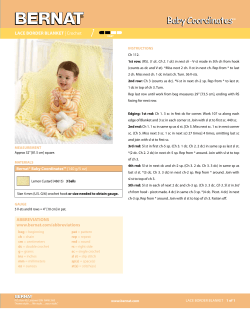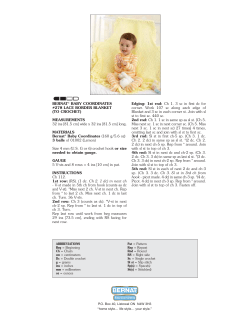
Notes on the Kuka LWR4 dynamic model. Massimo Cefalo
Notes on the Kuka LWR4 dynamic model. Massimo Cefalo Dipartimento di Ingegneria Informatica, Automatica e Gestionale Sapienza Universit` a di Roma Via Ariosto 25, 00185 Roma, Italy. Email: cefalo.m@gmail.com In this document I briefly discuss the dynamic parameters used to build the dynamic model of the Kuka LWR4 manipulator. All parameters come from direct assignments and measures. I want to underline that the supplied model is not the result of an identification process. It is expected to behave realistically and similarly to the real system, but several aspects make this model different from the real system. Just to cite some of them: 1. Motor dynamics is not modeled. 2. Friction is neglected. 3. Mass distribution is considered uniform. 4. Low level electronic controllers are not modeled. Inertia tensors and centers of mass have been computed in Meshlab (a CAD software application) using DXF files representing realistic shaped links. Each link has been supposed to have a uniform distribution of mass. Link bodies are represented by thick surfaces (similarly to hollow cylinders). The inner part of the link bodies is considered empty, even if in the reality it is occupied in greatest part by motors and cables. The computation of the link masses has been made taking into account the distribution of the motors along the structure, but each value comes only from empirical considerations and not from direct measures. Figure 1 on next page shows the kinematics parameters of the robot arm and two sets of reference frames. On the left it is shown a sequence of reference frames joined with the links that is compliant with the DenavitHartenberg convention (in the following called DH framework ). On the right side, for comparison, for each link it is shown the V-rep default reference frame (in the following called V-rep framework ): the origin of each reference frame is positioned at the center of the link’s bounding box. DH framework can be used to write the analytic equations of motion using the Euler-Lagrange approach. In the following, I report the inertia matrix and the position of the center of mass for each link. In particular: - I V rep is the inertia tensor for a unitary mass computed in a reference frame positioned at the center of mass of the body and oriented like the frames in the V-rep framework - I ′V rep = m · I V rep , where m is the link mass - I DH is the inertia tensor computed in a reference frame positioned at the center of mass of the body and oriented like the frames in the DH framework. We have I DH = RT I ′V rep R, where R is the rotation matrix that changes the orientation of the V-rep reference frame to the DH reference frame - pV rep is the position of the center of mass in the V-rep framework - pDH is the position of the center of mass in the DH framework. Observe that neither the V-rep framework nor the DH framework are composed by principal reference frames, i.e., reference frames for which the inertia tensors are diagonal. In V-rep, selecting ‘view’ → ‘visualize inertias’ from the contextual menu, it is possible to visualize a graphical representation of the inertia matrices associated to the objects of the scene. Such representation may help to understand how the principal axes of each link are oriented in the model. Link 1 m = 2.7 Kg 0.006052050623697 0.000000262598815 −0.000001121026777 0.001308542301422 I V rep = 0.000000262598815 0.005990028254028 −0.000001121026777 0.001308542301422 0.001861529721327 0.016340536683981 0.000000709016801 −0.000003026772299 ′ 0.003533064213839 I V rep = 0.000000709016801 0.016173076285877 −0.000003026772299 0.003533064213839 0.005026130247583 0.016340536683981 0.000003026772299 −0.000000709016801 0.003533064213839 I DH = 0.000003026772299 0.005026130247583 −0.000000709016801 0.003533064213839 0.016173076285877 0.00000154 pV rep = −0.008722 −0.014608 0.001340 pDH = −0.087777 −0.026220 −1 0 0 R = Ry (−180) · Rx (−90) = 0 0 1 0 1 0 Link 2 m = 2.7 Kg 0.006052053050237 −0.000000262495113 0.000001120725355 0.005990030680569 0.001308603692891 I V rep = −0.000000262495113 0.000001120725355 0.001308603692891 0.001861529842654 0.016340543235640 −0.000000708736804 0.000003025958460 0.016173082837536 0.003533229970806 I ′V rep = −0.000000708736804 0.000003025958460 0.003533229970806 0.005026130575166 0.016340543235640 −0.000000708736804 0.000003025958460 0.016173082837536 0.003533229970806 I DH = −0.000000708736804 0.000003025958460 0.003533229970806 0.005026130575166 0.000001541 pV rep = 0.008722 0.014608 0.001340 pDH = −0.026220 0.087777 1 R = 0 0 0 1 0 0 0 1 Link 3 m = 2.7 Kg 0.006052050623697 0.000000262383560 0.000001120384479 0.005990028254028 −0.001308542301422 I V rep = 0.000000262383560 0.000001120384479 −0.001308542301422 0.001861529721327 0.016340536683981 0.000000708435613 0.000003025038092 ′ 0.016173076285877 −0.003533064213839 I V rep = 0.000000708435613 0.000003025038092 −0.003533064213839 0.005026130247583 0.016340536683981 −0.000003025038092 −0.000000708435613 −0.003533064213839 I DH = −0.000003025038092 0.005026130247583 −0.000000708435613 −0.003533064213839 0.016173076285877 −0.000001541 pV rep = 0.008722 −0.014608 −0.001340 pDH = 0.087777 −0.026220 −1 0 0 0 −1 R = Ry (−180) · Rx (90) = 0 0 −1 0 Link 4 m = 2.7 Kg 0.006052050623697 I V rep = −0.000000262507583 −0.000001120888863 0.016340536683981 I ′V rep = −0.000000708770474 −0.000003026399929 0.016340536683981 I DH = −0.000000708770474 −0.000003026399929 −0.000001541 pV rep = −0.008722 0.014608 −0.001340 pDH = 0.026220 0.087777 1 0 0 R = 0 1 0 0 0 1 −0.000000262507583 −0.000001120888863 0.005990028254028 −0.001308542301422 −0.001308542301422 0.001861529721327 −0.000000708770474 −0.000003026399929 0.016173076285877 −0.003533064213839 −0.003533064213839 0.005026130247583 −0.000000708770474 −0.000003026399929 0.016173076285877 −0.003533064213839 −0.003533064213839 0.005026130247583 Figure 1: Kuka LWR4 kinematics parameters and reference frames. Link 5 m = 1.7 Kg 0.005775526977146 −0.000000448127278 0.005348473437925 I V rep = −0.000000448127278 0.000000782342032 0.001819965983941 0.009818395861149 −0.000000761816372 0.009092404844472 I ′V rep = −0.000000761816372 0.000001329981455 0.003093942172699 0.009818395861149 −0.000001329981455 0.003708097004077 I DH = −0.000001329981455 0.000000761816372 0.003093942172699 0.000006059 pV rep = −0.008171341 −0.03476408 −0.000993 pDH = −0.111650 −0.026958 −1 0 0 R = Ry (−180) · Rx (−90) = 0 0 1 0 1 0 Link 6 m = 1.6 Kg 0.000000782342032 0.001819965983941 0.002181233531810 0.000001329981455 0.003093942172699 0.003708097004077 0.000000761816372 0.003093942172699 0.009092404844472 0.001882302441080 0.000000003150206 −0.000000072256604 0.001889339660303 −0.000012066987492 I V rep = 0.000000003150206 −0.000000072256604 −0.000012066987492 0.002133520179065 0.003011683905727 0.000000005040330 −0.000000115610566 0.003022943456485 −0.000019307179987 I ′V rep = 0.000000005040330 −0.000000115610566 −0.000019307179987 0.003413632286504 0.003011683905727 0.000000005040330 −0.000000115610566 0.003022943456485 −0.000019307179987 I DH = 0.000000005040330 −0.000000115610566 −0.000019307179987 0.003413632286504 0.000000512 pV rep = −0.007574863 0.00136257 −0.000259 pDH = −0.005956 −0.005328 1 0 0 R = 0 1 0 0 0 1 Link 7 m = 0.3 Kg 0.0003390625 I V rep = 0 0 0.00010171875 I ′V rep = 0 0 0.00010171875 I DH = 0 0 0 pV rep = 0 0 0 pDH = 0 0.063 1 0 0 R = 0 1 0 0 0 1 0 0.0003390625 0 0 0.00010171875 0 0 0.00010171875 0 0 0 0.000528125 0 0 0.0001584375 0 0 0.0001584375
© Copyright 2025









